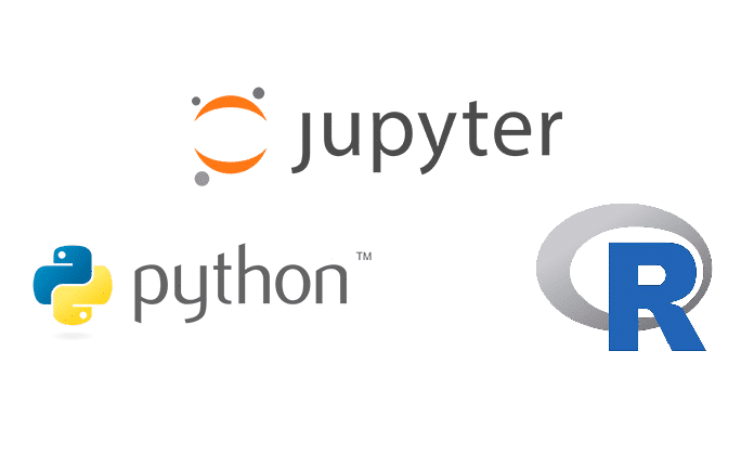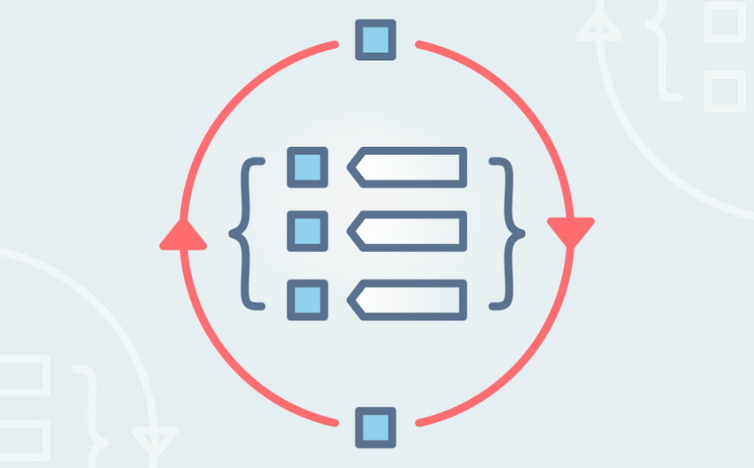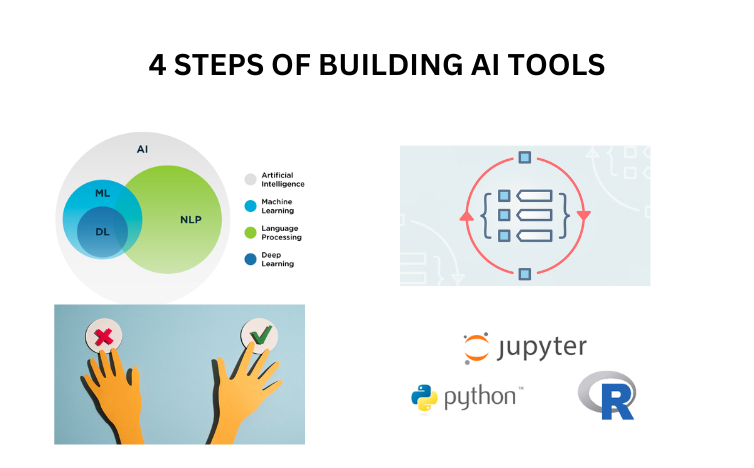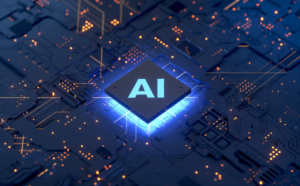Do you want to explore the wonders of artificial intelligence and see amazing things it can do? Whether you are a technology enthusiast, an avid learner or just inquisitive; this blog post is for you! You will learn everything on making your own AI tools from basic AI to very advanced machine learning programs. Be prepared for a fun-filled journey where you will be able to create interesting items using Artificial Intelligence and maybe, change the world! Let’s begin building some awesome AI tools together!
Table of Contents
Grasping the Fundamentals of AI
Before discussing about how to make AI, let’s take note of some core ideas. Essentially, AI involves making computers do smart stuff like humans do. It is a large field however it broadly covers three key points:

Machine Learning (ML)
Machine learning (ML) forms part of artificial intelligence that deals with algorithms which can predict and learn based on data. Through looking at lots of past data, these algorithms become more intelligent as they try to discover patterns and make guesses or decisions without being explicitly told what to do.
Deep Learning (DL)
Deep learning (DL) is a branch of machine learning that uses artificial neural networks similar to our brains in order to gain knowledge. These networks handle big amounts of data including complex problems such as picture identification or language comprehension.
Natural Language Processing (NLP)
NLP teaches computers how to read human languages, understand them and know their meaning. In creating natural sounding human-like interfaces for AIs, this aspect becomes significant.
Upon understanding these fundamental parts concerning AI, you have laid down a strong foundation for your journey into the world of AI.
Choosing the Right AI Project
It Is Important To Choose The Right AI Project
This step is important because picking something that interests you but is also appropriate for your level is critical. Here’s how:

Define Your Objectives
What are your objectives when undertaking an AI project? As such, if you have one, it will help in guiding your development process.
Assess Your Resources
Take into account the time, tools and data you have. For instance, if you work alone or with a small team,your project should be achievable with the resources you have available.
Identify Your Interest Areas
AI does lots of things like chatting with you or recognizing pictures. Therefore pick something that really interests you so that learning becomes enjoyable and problem solving easy. If your chosen project matches these principles then chances are good that you will succeed and have fun doing it.
Learning Key Programming Languages and Frameworks
The knowledge of certain programming languages and frameworks is very important when building AI tools. Beginners can start with the following foundational technologies to make the learning curve less steep:

Python
Python is considered as main language for AI because it offers many tools and is not hard to use. Python has a lot of stuff for AI projects like TensorFlow, Keras, PyTorch which are great starting points.
R
Another programming language commonly used for statistical analysis and Machine Learning is R. In case your project heavily involves statistics and data visualization; Python is up there alongside R that could be another viable option as well.
Jupyter Notebooks
Jupyter Notebooks are not a specific language; they are an online tool that helps you to create and share documents. These documents can contain codes, equations, images and explanations all in one place. They are commonly used for testing out ideas and exploring concepts in AI projects.
When you are comfortable with these tools, you can move on to more complex languages and frameworks when necessary.
Learn more: AI Tools For Business
Understanding Data Preprocessing
One of the important steps of any AI project is data preparation. Often this requires cleaning up data, handling missing values, normalizing it among others. A proper preprocessing process ensures that the model gives as accurate results as possible.

Exploratory Data Analysis
EDA is understanding the ‘shape’ of your data – its statistical properties, distribution and how different attributes relate. Tools such as ggplot2 in R or Pandas in Python are fantastic for EDA.
Feature Engineering
Features represent the inputs to your model in AI context. Feature engineering consists of creating new features, choosing which ones matter most and refining them so that your models will work better.
Data Splitting
After preparing your data, you split it into three parts: training set, validation set and test set. The model has been taught by the training set while the validation set adjusts settings whereas testing looks at how well this model works.
Remember to carefully prepare your data because this also affects how good and useful your AI model would be.
Model Building and Training
Once you have preprocessed your data then build/ train an AI model using it.you select ideal architecture layer(s), loss functions(s)and optimizer(s).
Model Selection
The type of problem determines what kind of model to choose from different options available – things like classifying items into groups or making predictions about them or organizing information concerning them.If at first users should begin with simpler models depending on their level such as Decision Trees or Logistic Regression before progressing onto neural networks.
Hyperparameter Tuning
Hyperparameters are special settings for your learning algorithm. To find the best values for your model, you have to do hyperparameter tuning. This often involves trying out different settings using methods like grid search or random search.
Training and Evaluation
You train your model by exposing it to a large amount of data so that it understands the patterns within it. During training, you will observe its performance and make changes to the model based on that feedback. Metrics like accuracy, precision, recall and F1-score can help in making adjustments to the model.
By constantly improving and testing your model, you will come up with a great AI tool in no time.
Validating and Deploying Your Model
It is good practice to ensure that before applying our models we confirm they actually work well even with new data as opposed to just training data. In order to perform this check usually techniques such as cross-validation and A/B testing are used.
Cross-Validation
Cross-validation is a procedure where the dataset is broken down into many subsets; each subset being used once as a test set while all remaining ones used for training.
A/B Testing
For example when we use models in things people use like apps, we might compare an original one with a modified one—just to see which one works better.A/B testing describes this situation.
After you have guaranteed that your model is in fine form, it is ready for utilization, which depends on what type of application you wish to put it into; you can add it directly into software or make it available to others online through something called an API.
Tips for Building AI Tools
Here are some few important tricks that can help you build AI tools:

Clearly Know Your Goals: Make sure that before you start building your AI tool, you understand the problem that you want to solve or the job that you want it do. This helps not to deviate from one’s course as the tool is being made.
Choose Good Data: The data used in your AI tool matters a lot. Take data that is related and has good coverage of various situations.
Understand AI’s Limits: As much as artificial intelligence is amazing, there are things it cannot handle. Understand the capabilities and incapacities of AI.
Pick the Right Method: Depending on what the object of your desire from them is, there are several approaches for creating artificial inteligence devices. Just select that which suits best with your work.
Keep Testing and Fixing: Building a nice AI tool takes time. Continue testing, fixing problems and improving it.
Be Ethical: Given its impact, AI should be thought about in terms of how it affects people’s lives. Ensure your tool is one that promotes fairness without any harm to anyone
Think About Users: Think about who will use this when making it so as to meet their needs therefore consider creating user-friendly tools.
Stay Updated: It remains critical to keep learning new developments in this ever-changing world of Artificial Intelligence (AI). This will help maintain current relevance and usefulness too.
You can make sure they’re great at what they do and contribute significantly towards solving important problems by following these instructions for developing good AI tools.
Conclusion
Getting started with making stuff using artificial intelligence (AI) technologies may be very fascinating as well as it can easily lead to personal and professional growth. You are now ready to create your first AI tool by following the steps in this guide.
To keep learning, join online groups, go to workshops, and work on projects with others. As you become more advanced, attempt more challenging assignments and stay up-to-date on what’s happening in AI.
FAQS
So what exactly are AI tools and how do they operate?
AI tools refer to software applications that use artificial intelligence techniques in performing tasks. They analyze data, learn from it, and then make decisions or predictions based on that learning basis.
What coding languages must I know?
Python is a preferred language for AI due to its simplicity of use as well as many Machine Learning (ML) tools contained therein for Data Analysis tasks.
Do I need a lot of data?
It depends. More data may help but simple AI tools can still be developed with little data.
How do I pick the right method?
You should select one according to your problem at hand. For example if you are categorizing items into classes use a decision tree whereas when identifying images apply convolutional neural networks.




